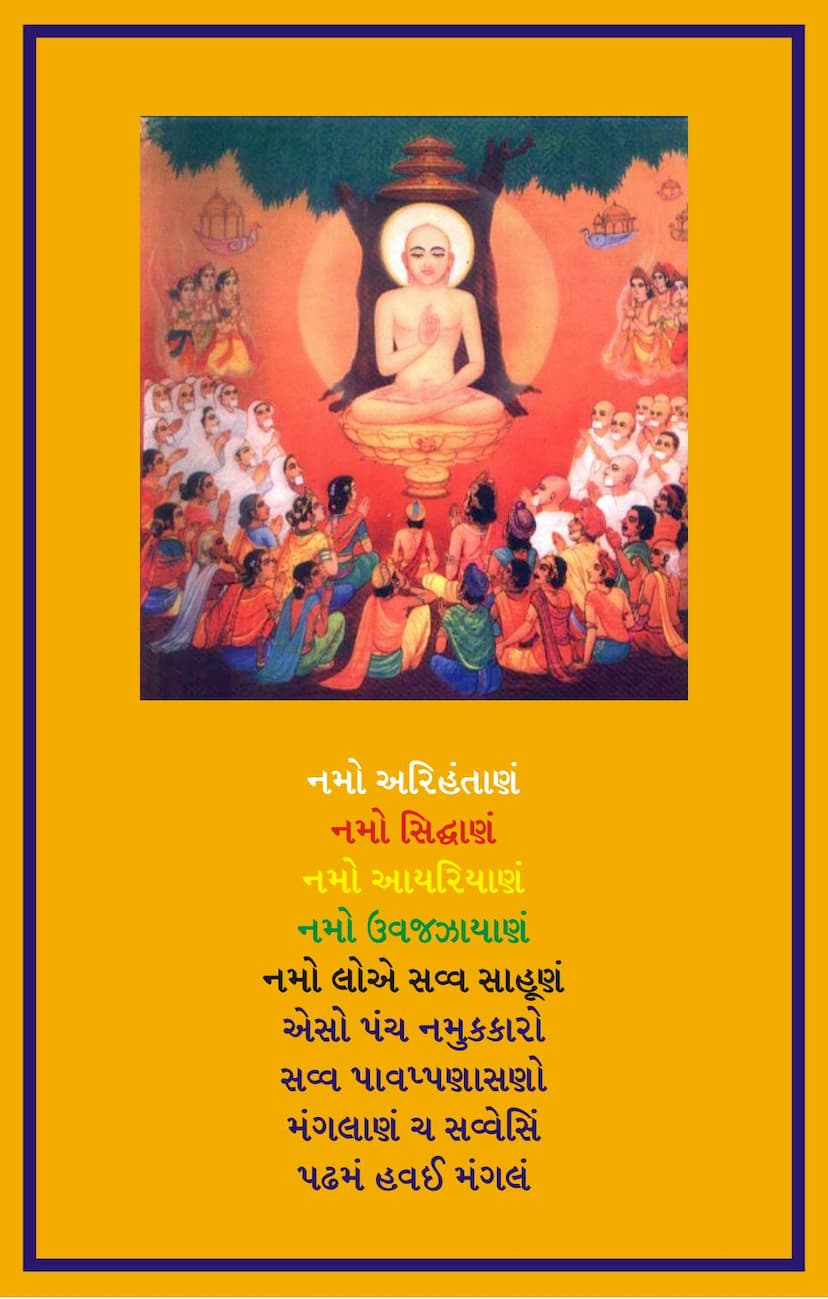Agam 05 Ang 05 Bhagvati Vyakhya Prajnapti Sutra Part 16 Sthanakvasi
Added to library: September 1, 2025

Summary
This Jain text, Agam 05 Ang 05 Bhagvati Vyakhya Prajnapti Sutra Part 16 Sthanakvasi by Ghasilal Maharaj, published by A B Shwetambar Sthanakvasi Jain Shastroddhar Samiti, is the 16th part of a larger commentary on the Bhagvati Sutra. This specific volume focuses on the teachings of the Shwetambar Sthanakvasi tradition.
The text begins with the universal Jain invocation:
- "Namo Arihantanam" (Homage to the Arihants)
- "Namo Siddhantam" (Homage to the Siddhas)
- "Namo Acharyanam" (Homage to the Acharyas)
- "Namo Upadhyayanam" (Homage to the Upadhyayas)
- "Namo Lokeshu Sarva Sadhunam" (Homage to all Sadhus in the world)
- "Esa Panch Namukkaro Savva Pavappanasano Mangalanan cha Savvasim Pathamam Havai Mangalam" (This five-fold salutation destroys all sins and is the first auspicious of all auspicious things).
The book is presented as part of the "Agam Prakashan Yojana" and includes a commentary by Acharya Shri Ghasilalji Maharaj. The publisher and organizer, Shri Akhil Bharat S. S. Jain Shastroddhara Samiti, Rajkot, are credited. The first edition was printed in 1972 (Vir Samvat 2498, Vikram Samvat 2028).
The Bhagavati Sutra Part 16 appears to be a comprehensive work, as indicated by the extensive table of contents (viṣayānukramaṇikā) found on pages 11-14. This table details the subjects covered in this part of the text, which includes:
- Chapter 25, 5th Uddeshak (Section): Discussions on "Paryay" (states or modes of being), temporal periods like "Sagaropam," and classifications of "Nigoda" (a fundamental Jain concept of basic life forms).
- Chapter 25, 6th Uddeshak: This section is particularly detailed, covering 36 "Dwar" (gates or topics of discussion). These include:
- Prajnapan (Chapter on definitions/exposition)
- Ved (Feeling/sensation)
- Raga (Attachment/passion)
- Kalpa (Cosmic realms)
- Charitra (Conduct/discipline)
- Pratisēvana (Consumption/indulgence)
- Jnana (Knowledge)
- Tirtha (Sacred places/teachings)
- Linga (Signs/characteristics)
- Sharira (Body)
- Kshetra (Region/space)
- Kala (Time)
- Gati (Destiny/realm of existence)
- Samyama (Restraint)
- Nikasha (Proximity/contact)
- Yoga (Union/activity)
- Upayoga (Attention/application)
- Kashaya (Passions)
- Leshyā (Psychic color/disposition)
- Parinama (Transformation/modifications)
- Bandha (Bondage)
- Udirana (Emanation of karma)
- Upasampad (Attainment)
- Sanjna (Consciousness/perception)
- Ahara (Nourishment)
- Bhava (Existence/state of being)
- Akarsha (Attraction)
- Kalmana (Time measurement)
- Antara (Interval)
- Samudghata (Emanation of energy)
- Sparshana (Touch)
- Bhava (State of being/mental state)
- Parimana (Quantity/measure)
- Alpabahutva (Less-more)
- Chapter 26, 1st Uddeshak: Further discussion on "Bandha" (bondage), "Tapa" (asceticism), and "Dhyana" (meditation).
- Chapter 26, 8th Uddeshak: Focus on the origins of beings in Naraka (hellish realms) and those destined for liberation ("Bhavasiddhik").
Key themes and discussions found within the provided pages, particularly related to the detailed rules of "Swadhyay" (self-study) on pages 6-10, include:
-
Timing of Swadhyay: The text specifies that the original text of the Sutra should be studied during the first and fourth quarters of the day and night. Certain periods, like dawn, dusk, noon, and midnight, are considered inauspicious for study, specifically 24 minutes before sunrise and 24 minutes after sunrise.
-
Abstinence from Swadhyay (Aswadhyay): A significant portion of the text outlines 32 specific circumstances under which Swadhyay is prohibited. These are categorized into:
- 10 Circumstances related to the Sky (Akasha Sambandhi): Falling stars (Ulkaapāt), directional burning (Digdāha), thunderous roars of clouds (Garjarav), divine roars in the sky (Nirghata), lightning flashes (Vidyut), specific lunar phase phenomena (Yūpak), light from deities (Yakṣādīpta), smoky fog (Ghūmikā Kṛṣṇa), white fog (Mahikā Śveta), and dust storms obscuring the sun (Rajo'dghāta).
- 10 Circumstances related to the Physical Body (Audārika Sharira Sambandhi): Unburnt or unwashed bodily remains (bones, flesh, blood), broken eggs, visible excrement and urine with foul odor, proximity to a cremation ground (within 100 cubits), lunar and solar eclipses (with specific durations of prohibition), royal disturbances (Rajavyagrata), deaths of prominent figures (Patan) until cremation and successor appointment, and the presence of a dead body (of a Panchendriya being) within or near the Upāśraya (monastic dwelling).
- 8 Days related to Festivals and their Eves (Chāra Mahotsava āni Chāra Pratipada): Specifically mentioning four full moon festivals (Asadha, Asho, Kartik, Chaitra) and the four days following them (Pratipada in the dark fortnight).
- Specific Daily Times: Two additional periods of prohibition are mentioned: one ghadi (24 minutes) before sunrise and after sunset (covering twilight periods), and one ghadi before midday and midnight.
-
Flexibility and Respect: The text acknowledges that these rules are primarily for the original text and not necessarily for translations. It emphasizes the importance of Vinaya (respect and humility), especially towards elders and teachers, in navigating these situations.
The initial pages (1-4) also include publisher information, dedications, and a verse in Hindi and Gujarati emphasizing the importance of time and the vastness of knowledge.
The later pages (15 onwards) delve into the philosophical discussions of the Bhagavati Sutra, starting with the classification of "Paryavā" (states or modes of being) into "Jiva Paryavā" (states of living beings) and "Ajiva Paryavā" (states of non-living matter). The text meticulously breaks down concepts related to time, enumerating various units and their relationship to the counts of "Samaya" (time units) and "Āvali" (a very short measure of time). The discussions then progress to detailing the types of "Nigoda" (basic life forms) and the concept of "Nama" (names or categories), outlining six types and then further elaborating on the classification of "Audārika" (gross physical body) and its relation to other forms.
The later chapters, starting from the 6th Uddeshak, begin to systematically explore the 36 "Dwar" (gates or topics) related to the conduct and classification of Jain monks (Nirgranthas), as detailed in the table of contents. This includes discussions on various spiritual states, karmic actions, and the nuances of Jain practice and philosophy.
In essence, this volume is a detailed, traditional commentary on a significant portion of the Bhagavati Sutra, offering insights into Jain cosmology, philosophy, and the rules governing the practice of self-study. It emphasizes the importance of adhering to specific observances and respecting spiritual hierarchy.